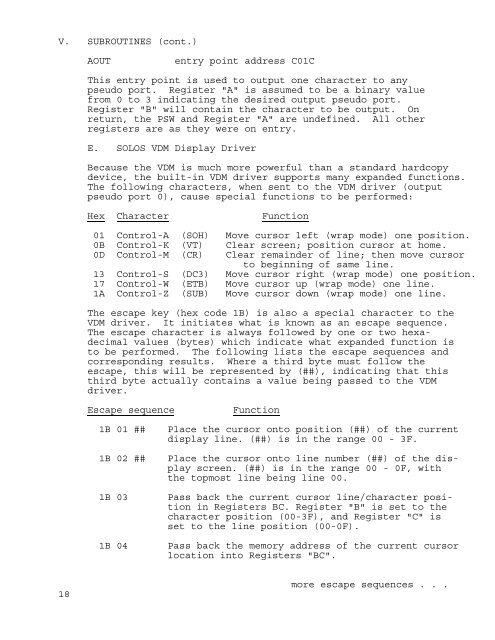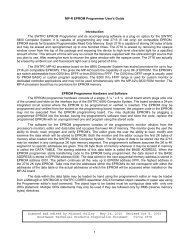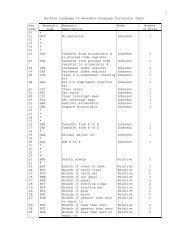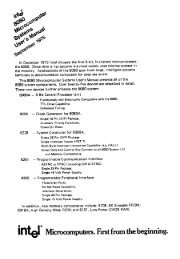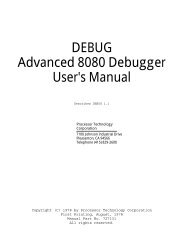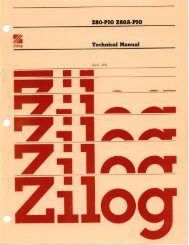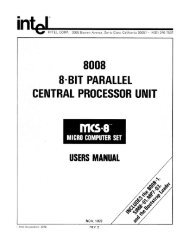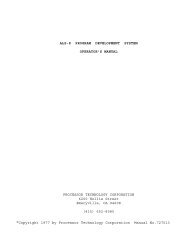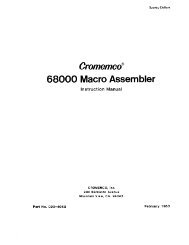The System Manual of SOL-20 - History of Computers
The System Manual of SOL-20 - History of Computers
The System Manual of SOL-20 - History of Computers
You also want an ePaper? Increase the reach of your titles
YUMPU automatically turns print PDFs into web optimized ePapers that Google loves.
V. SUBROUTINES (cont.)<br />
AOUT<br />
entry point address C01C<br />
This entry point is used to output one character to any<br />
pseudo port. Register "A" is assumed to be a binary value<br />
from 0 to 3 indicating the desired output pseudo port.<br />
Register "B" will contain the character to be output. On<br />
return, the PSW and Register "A" are undefined. All other<br />
registers are as they were on entry.<br />
E. <strong>SOL</strong>OS VDM Display Driver<br />
Because the VDM is much more powerful than a standard hardcopy<br />
device, the built-in VDM driver supports many expanded functions.<br />
<strong>The</strong> following characters, when sent to the VDM driver (output<br />
pseudo port 0), cause special functions to be performed:<br />
Hex Character Function<br />
01 Control-A (SOH) Move cursor left (wrap mode) one position.<br />
0B Control-K (VT) Clear screen; position cursor at home.<br />
0D Control-M (CR) Clear remainder <strong>of</strong> line; then move cursor<br />
to beginning <strong>of</strong> same line.<br />
13 Control-S (DC3) Move cursor right (wrap mode) one position.<br />
17 Control-W (ETB) Move cursor up (wrap mode) one line.<br />
1A Control-Z (SUB) Move cursor down (wrap mode) one line.<br />
<strong>The</strong> escape key (hex code 1B) is also a special character to the<br />
VDM driver. It initiates what is known as an escape sequence.<br />
<strong>The</strong> escape character is always followed by one or two hexadecimal<br />
values (bytes) which indicate what expanded function is<br />
to be performed. <strong>The</strong> following lists the escape sequences and<br />
corresponding results. Where a third byte must follow the<br />
escape, this will be represented by (##), indicating that this<br />
third byte actually contains a value being passed to the VDM<br />
driver.<br />
Escape sequence<br />
Function<br />
1B 01 ##<br />
1B 02 ##<br />
1B 03<br />
1B 04<br />
Place the cursor onto position (##) <strong>of</strong> the current<br />
display line. (##) is in the range 00 - 3F.<br />
Place the cursor onto line number (##) <strong>of</strong> the display<br />
screen. (##) is in the range 00 - 0F, with<br />
the topmost line being line 00.<br />
Pass back the current cursor line/character position<br />
in Registers BC. Register "B" is set to the<br />
character position (00-3F), and Register "C" is<br />
set to the line position (00-0F).<br />
Pass back the memory address <strong>of</strong> the current cursor<br />
location into Registers "BC".<br />
18<br />
more escape sequences . . .


